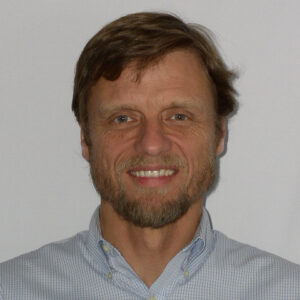Peter Vrolijk
New Mexico Tech
2023-2024 Distinguished Lecturer
Massive earthquakes and tsunamis: Contributing factors revealed by IODP Exp. 362
On the day after Christmas, 2004, the world awoke to an immense tragedy – one of the largest earthquakes ever recorded (Mw 9.2) struck Sumatra in Indonesia. In the following hours and days, the tragedy grew as a massive tsunami swept around the Indian Ocean and world, inundating coastal communities with tremendous loss of life.
Our appreciation of the variability of subduction zone earthquakes has grown in the past decades and encompasses non-destructive, slow-slip earthquakes, like those along the Hikurangi margin of New Zealand, and massive, destructive tremors, like the Sumatra earthquake (and everything in between). IODP Expedition 362 sailed in summer of 2016 to evaluate whether the thick sedimentary section subducted at the Sumatra margin consists of materials that through burial and diagenetic processes could contribute to one of the largest earthquakes recorded and rupture the seafloor and trigger a devastating tsunami. We discovered a ca. 1300 m turbidite fan section (Nicobar Fan) dominated by detritus eroded from the Himalayas and deposited within 7 m.y. Early, low-temperature diagenetic reactions (opal transformations) were detected, and burial, thermal, and diagenetic modeling suggest that many diagenetic processes, like smectite-illite transformation, may be advanced by the time the sediments start subduction and may no longer contribute to overpressures created under the rapid loading of subduction. Cementation processes, like quartz cement formation, may also have begun in the section prior to subduction initiation, further contributing to an overall stronger section than found at most subduction margins. These results offer one more constraint on the myriad expressions of subduction zone seismicity.
Peter Vrolijk is an Adjunct Professor at New Mexico Tech and pursues a number of retirement interests, including participation in IODP Expedition 362 and post-expedition research. Following B.S. and M.S. degrees at MIT and a PhD at U. C. Santa Cruz, exploring fluid flow processes in shallow subduction zones, and post-docs at Cambridge University and the Univ. of Michigan, he pursed a research career at Exxon and Exxon-Mobil, retiring in 2016 just in time to join IODP Expedition 362. Throughout his career he has worked on a wide variety of problems, encompassing methods development for fault dating, normal fault processes, and subsurface fluid flow methods, but he has always maintained an interest in subduction zone processes.
In retirement Peter has pursued select research projects that have afforded him the opportunity to support developing student scientists, including the Sumatra expedition and the development of autonomous underwater exploration methods on the Costa Rican subduction margin. In addition, volunteer activities in local wilderness areas and MIT undergraduate student recruitment provide opportunities for fruitful use of retirement time.
LECTURE SCHEDULE
- October 5, 2023 – Colorado School of Mines, Golden, CO
- October 12, 2023 – Oklahoma State University, Stillwater, OK
- December 6, 2023 – University of Miami, Miami, FL
- February 1, 2024 – New Mexico Tech, Socorro, NM
- February 15, 2024 – University of Kansas, Lawrence, KS
- February 22, 2024 – Fort Lewis College, Durango, CO
- February 27, 2024 – MIT Club of Colorado, Colorado School of Mines, Golden, CO
- February 29 – March 1, 2024 – University of Houston, Houston, TX
- April 3, 2024 – Auburn University, Auburn, AL
- April 5, 2024 – University of Georgia, Athens, GA







